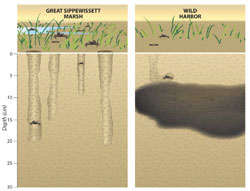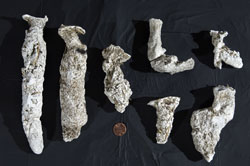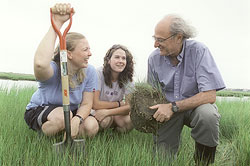April 23, 2007Source: Media RelationsNearly four decades after a fuel oil spill polluted the beaches of Cape Cod, researchers have found the first compelling evidence for lingering, chronic biological effects on a marsh that otherwise appears to have recovered. Through a series of field observations and laboratory experiments with salt marsh fiddler crabs (Uca pugnax), doctoral student Jennifer Culbertson and colleagues found that burrowing behavior, escape response, feeding rate, and population abundance are significantly altered when the crabs are exposed to leftover oil compounds from a 1969 spill. The study builds on previous work by researchers from the Woods Hole Oceanographic Institution (WHOI), which showed that oil compounds from the 1969 wreck of the barge Florida are still lingering in the sediments 8 to 20 centimeters below the surface of Wild Harbor in Falmouth, Mass. Burrowing fiddler crabs in the marsh still won’t dig more than a few centimeters into the sediments in the areas most affected by the spill. Culbertson a graduate student from the Boston University Marine Program (BUMP) and a guest student at WHOI, conducted the research in collaboration with WHOI marine chemist Chris Reddy, ecologist Ivan Valiela of the Marine Biological Laboratory, and several student colleagues from WHOI and BUMP. The findings were published in the online version of Marine Pollution Bulletin on April 19, 2007 and it will appear later this spring in a printed edition. Culbertson’s experiments and field work were conducted in the summer of 2005 and 2006 in the Great Sippewissett and Wild Harbor marshes of Falmouth. On the surface, these neighboring marshes look quite similar, with common plants and animals, sediment types, and geologic histories. The difference is that WHOI researchers have detected residues of No. 2 fuel oil buried in the sediments Wild Harbor, while Great Sippewissett has no detectable residues of the 1969 spill. “There are outward signs that the marsh in Wild Harbor has recovered,” said Reddy, whose lab group has been studying Cape Cod oil spills for nearly a decade. “But there is still chemical warfare going on just a few centimeters beneath the surface.” To study the burrowing behavior of Uca pugnax—which digs burrows for shelter while aerating the soil—Culbertson and colleagues poured Plaster of Paris into 31 burrows in the two marshes. They later removed the casts of the burrows from the marsh mud and measured dimensions and shape. Crabs that burrowed into the relatively pristine marsh of Great Sippewissett made holes that were straight and stretched an average of 14.8 centimeters (the longest was 18 cm). In Wild Harbor, the burrows averaged 6.8 cm (none were deeper than 14) and showed erratic shapes as the fiddler crabs halted or turned laterally. The locations of the stunted, twisted burrows mapped closely with the location of residual oil in the sediments. Researchers also observed the escape response of the crabs, both in the marsh and in the lab. After catching fiddler crabs from both marshes, the scientists fed them sediments from either the oiled or clean marsh and used visual stimuli—a 5 by 5 cm weighted black square, swinging in front of the crab—to test how long they took to move away from it. Crabs fed with oiled sediments were significantly slower to respond, which matched what Culbertson observed in the wild. “It was shocking that you could bend over and poke the crabs, even flip them over, and they were slow to get up,” said Culbertson of the fiddler crabs who are difficult to observe, no less catch, when healthy. “It was as if they were drunk.” Culbertson and colleagues also examined how quickly crabs consumed food when exposed to oil (much more slowly) and counted the numbers of crabs in each marsh (there were half as many in the oil-tainted marsh). "It has been difficult to demonstrate the biological effects of oil spilled long ago,” said Valiela. “This work provides clear evidence. Jen was able to establish a link between residual oil contents and the onset of biological effects, which will help establish guidelines for management actions after future oil spills." The research by Culbertson builds upon similar Plaster of Paris studies conducted by WHOI graduate student Kathy Burns and BUMP student Charles Krebs in the 1970s. It also continues research by Reddy, his lab mates, and students, who first showed in 2002 that residues of the oil from the 1969 spill are still present in marsh sediments. Most recently, graduate student Emily Peacock has mapped and modeled the concentrations of oil at various locations in Wild Harbor; Culbertson relied on Peacock’s assessment of oil “hot spots” for the new research. Funding for this work was provided by the WHOI Sea Grant Program, under grants from the National Oceanic and Atmospheric Administration; by the Research Experience for Undergraduates program of the National Science Foundation; an Environmental Protection Agency Science to Achieve Results Graduate Fellowship; and the Young Investigator Program of the U.S. Office of Naval Research. # # #
The Woods Hole Oceanographic Institution is a private, independent organization in Falmouth, Mass., dedicated to marine research, engineering, and higher education. Established in 1930 on a recommendation from the National Academy of Sciences, its primary mission is to understand the oceans and their interaction with the Earth as a whole, and to communicate a basic understanding of the ocean's role in the changing global environment. Originally published: April 23, 2007 Last updated: July 28, 2014 | ||||||||||||||||||||||||||||
Copyright ©2007 Woods Hole Oceanographic Institution, All Rights Reserved, Privacy Policy. | ||||||||||||||||||||||||||||




